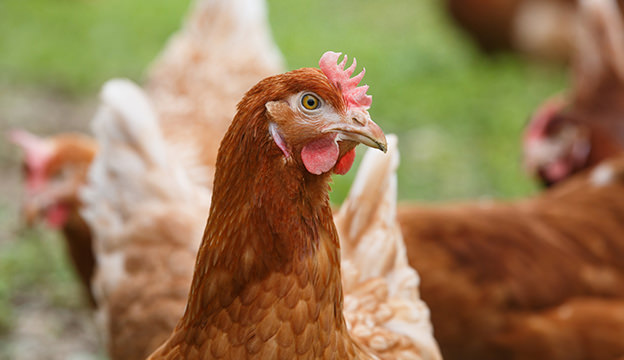
Infectious diseases do not spontaneously appear in chicken flocks. Almost all infectious diseases are introduced into a flock by means that go unnoticed, such as inadvertently carring an infectious disease on shoes or clothing and then tending to chickens.
Just as common are introductions of disease from equipment, feed, other animals, pests, vermin, migratory waterfowl, and most commonly, from new chickens introduced to an existing flock.
1. Keep Chickens Clean
Preventing disease in flocks entails proper management and sanitation practices, such as thorough cleaning of equipment and of facilities with proper disinfectants, and minimizing or eliminating the introduction of new chickens to your flock.
Biosecurity measures such as limiting contact with visitors and preventing contact with other birds such as ducks, sparrows and pigeons will reduce the risk of disease in your chickens.
2. Disinfect the Coop
Routine disinfecting of the chicken coop is one of the single most important things you can do to for your flock. Here are some things to keep in mind when disinfecting:
- Clean all coop surfaces with a detergent. Disinfectants work best on cleaned surfaces, but remember that a clean surface does not mean a disease-free surface.
- Disinfectants are not effective immediately after application—they require at least 30 minutes to destroy infectious organisms.
- Warm disinfectant solutions break up residue better than cold solutions.
- Let all surfaces dry completely before using. Remember to follow the manufacturer’s recommendations for dilution and use. Common disinfectants include hydrogen peroxide, iodine and chlorine.
3. Quarantine Chickens if Necessary
When an unhealthy chicken is noticed, it is important to immediately quarantine it and accurately diagnose the disease. By expediting the treatment of infected birds, you’ll prevent further spread of the disease.
4. Vaccinate Chickens for Problematic Diseases
Vaccination is seldom used by small-flock owners due to the expense and limited availability of vaccines, the simple lack of disease in small flocks, the unknown presence of disease and the improper diagnosis of disease.
Vaccination should be performed if birds have had a disease problem in the past, if they are transported on and off premises regularly and if birds are continually introduced to an existing flock.
Good husbandry should provide the small-flock owner and hobbyist with healthy, disease-free chickens without the heavy use of medications.
5. Know the Top Chicken Diseases
In general, a sick chicken is less active, retracts its neck close to its body and has an unkempt appearance, but not all diseases have the same presentation. Here are 11 common chicken diseases to be aware of:
- Pecking and Cannibalism
Symptoms: Early signs include continuous toe-picking in chicks, pecking at maturing feathers in growing chickens, or head and vent pecking in older chickens. It’s essential to pay close attention to the entire flock to determine the difference between random pecking and problematic behavior. Normal flock behavior does include the establishment of a “pecking” order. Read more » - Rickets
Symptoms: Chicks develop rubbery bones that cannot support their body weight. In severe cases, the chicks are unable to walk and die of suffocation as their bones cannot support the muscle movements required for breathing. In marginal cases, chicks have a stiff gait, decreased growth and eventual bone deformities, especially in the legs. Read more » - Vitamin A Deficiency
Symptoms: Chickens develop a crusty material in the nostrils and eyelids, progressing to the accumulation of a cheesy material. In the initial stages, it mimics respiratory diseases. Similar damage in the throat makes swallowing difficult. Deficient chicks fail to grow, are severely depressed and die of organ failure. Adult hens experience a drop in egg production, and breeding birds experience a drop in hatchability. Read more » - Lice Infestation
Symptoms: Chickens act nervously, and scratch and peck themselves frequently. Feathers look dry and ruffled. Eventual weight loss and decreased egg production occurs. Read more » - Coccidiosis
Symptoms: Chickens exhibit diarrhea, weight loss and pigmentation loss. Severe infections cause bloody diarrhea and could be fatal without treatment. Read more » - Ascaridiasis (Roundworm)
Symptoms: Common signs in chickens are diarrhea and weight loss. In severe infestation, masses of adult worms can cause a blockage of the intestine, which can be fatal if not treated. When large numbers of larvae or immature worms migrate through the lining of the gut, they cause severe inflammation. Read more » - Capillariasis (Hairworm)
Symptoms: Signs of hairworm infection include paleness, diarrhea and wasting. It can be fatal if severe cases are left untreated. Read more » - Mycoplasmosis
Symptoms: Watery eyes, dirty nostrils, coughing and sneezing are exhibited in chickens and are slow to develop. Egg production, fertility and hatchability are decreased. Over time, infection can lead to the accumulation of a “cheesy” material in the eyelids and sinuses as well as noticeable outward swelling. Read more » - Colibacillosis
Symptoms: Chickens appear listlessness, have ruffled feathers and labored breathing, and cough frequently. Severely infected chickens may exhibit diarrhea, swelling, and congestion of the liver and spleen. Newly hatched chickens sometimes exhibit a navel infection. Read more » - Fowl Cholera
Symptoms: Sudden death can occur, sometimes without signs of infection. Signs of infection can be severe depression, cyanosis (dark-purple discoloration of skin) and mucus coming out of the beak. The chronic form of this disease is usually characterized by localized infections in the face, wattles, sinuses or joints. Infection in the cranium can cause twisting of the neck, called torticollis. Read more » - Fowl Pox
Symptoms: Fowl pox causes round, raised lesions with “scabby” centers, usually located on the comb, wattle and face, and occasionally on the legs. Infections to the lining of the mouth and the windpipe can also occur. The lesions in the throat can grow to cause complete blockage and possibly death by suffocation. Chickens could be temporarily or permanently blinded if lesions spread to the eyes. Read more »




